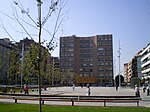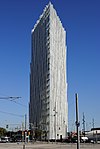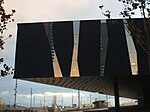Primavera Sound (popularly also known as Primavera) is an annual music festival held in Parc del Fòrum in Barcelona, Spain that takes place between the end of May and beginning of June. The first edition took place in 2001 in Poble Espanyol and moved to the Parc del Fòrum, a much larger site on the seafront, in 2005. The nature of the festival (urban and an integrated part of the city) and the wide range of bands represented have made Primavera Sound a meeting point for artists and spectators from all generations. Primavera Sound is one of the largest and most-attended music festivals in Europe and the biggest in the Mediterranean.The success of the festival led to an expansion to Porto in 2012. This one takes place at the Parque da Cidade a week after the main edition. Four new counterparts will be inaugurated in 2022 as new editions are scheduled to take place in Los Angeles, Santiago de Chile, Buenos Aires and São Paulo. A much smaller version of the festival, Primavera Weekender, has been taking place in Benidorm each November since 2019.The festival presents all genres including pop, indie, rock and the most underground tendencies of electronic and dance music.
Pixies, Arcade Fire, Queens of the Stone Age, The National, Nine Inch Nails, Kendrick Lamar, Neil Young, Sonic Youth, Portishead, Pet Shop Boys, Pavement, Echo & The Bunnymen, Lou Reed, My Bloody Valentine, El-P, Pulp, Patti Smith, James Blake, Cat Power, Public Enemy, Grinderman, Franz Ferdinand, Television, Devo, Enrique Morente, The White Stripes, LCD Soundsystem, Tindersticks, PJ Harvey, Shellac, Dinosaur Jr., New Order, Fuck Buttons, Swans, Melvins, Psychic TV, Spiritualized, The Cure, Bon Iver, La Buena Vida, Death Cab For Cutie, Iggy & The Stooges, De La Soul, Marianne Faithfull, Mazzy Star, Blur, Wu-Tang Clan, Phoenix, Radiohead, Animal Collective, Sigur Rós, The Jesus and Mary Chain and Tame Impala amongst many others have performed on its stages.
At every edition the event has grown both in terms of numbers and in terms of media exposure: press, radio and television both nationally and internationally. Its first edition in 2001 closed with an attendance of 8,000 people, an audience that by the latest edition in 2019 had become 220,000.








